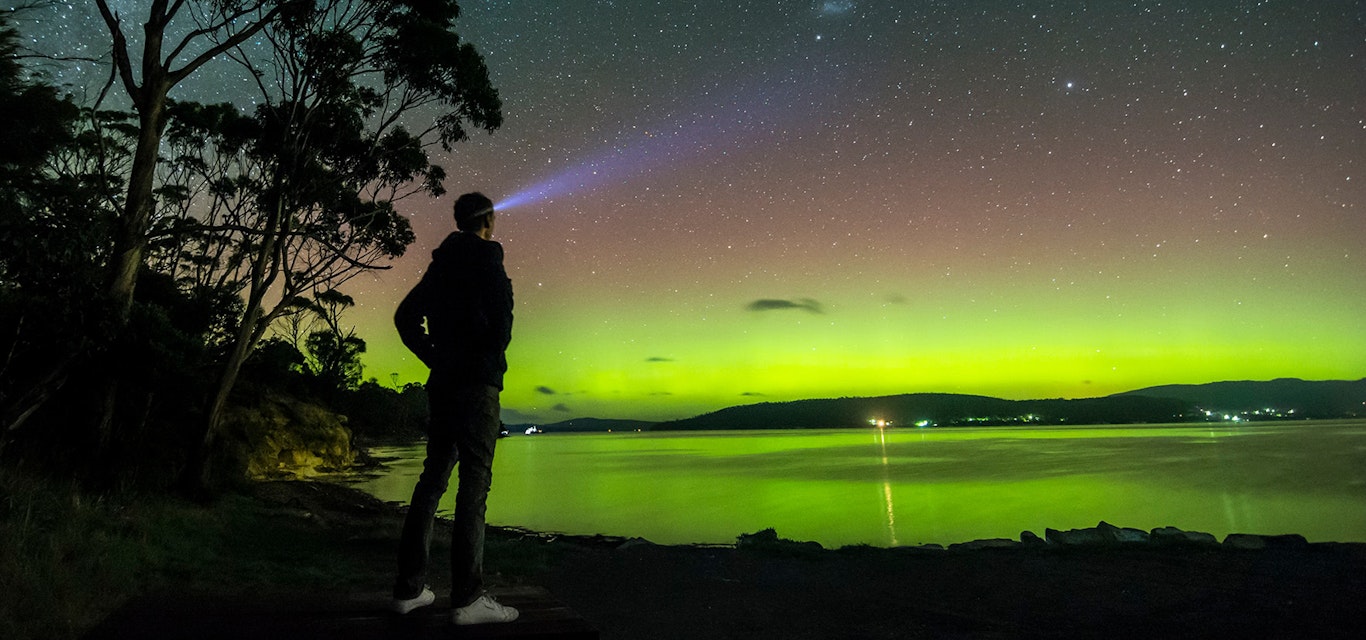See the light
In the depths of winter there are things that dazzle across Tasmania far beyond the man-made.
In the isolation and purity of its position, Tasmania has a sky that dances with celestial lights, an ocean that flares with bioluminescence, and glow worms and ghost mushrooms that add neon touches to the land. Look up, look down, look around – there’s light on the horizon.
Night lights
The star feature in Tasmania’s winter light show is the aurora australis, or southern lights. The southern sibling to the northern hemisphere’s famed aurora borealis, the southern lights are the result of solar wind bursts from the sun carrying electrically charged particles into the Earth’s atmosphere, where they collide with gases and emit brilliant light. The southern lights don’t get the same international attention as the northern lights primarily because there are fewer inhabited land masses from which to observe them. But outside of Antarctica, Tasmania is one of the best places in the world to view this night-sky spectacular, which, like most natural phenomena, is an unpredictable beauty. The best chance of sighting the aurora australis is to find a place away from light pollution, choose the darkest time of night, and, typically, head south. Cockle Creek, South Arm, Howden and Tinderbox are popular viewing spots. Photos typically depict aurora displays as dazzling drapes of green, purple and yellow light, though that’s a product of long shutter exposures, so expect a fainter – but still fantastic – display of cosmic colour.
Credit: Pierre Destribats and Tourism Tasmania
Credit: @whoishollyjean
Wonders of the worm
Brighter to the naked eye is the light of glowworms, which do exactly what their name suggests. Though they aren’t actually worms (they are an insect larvae), they most certainly glow, lighting their abdomens to attract prey. Tasmania’s most radiant display is found inside Marakoopa Cave, which contains a chamber covered in these tiny creatures, creating a virtual night sky lit with glow-worms instead of stars. Marakoopa Cave can be visited on ranger-led tours from Mole Creek. Mystery Creek Cave, near Ida Bay in the far south, is also home to glow-worms. Above the ground, there’s a grotto of glow-worms beside the walking trail to Russell Falls in Mount Field National Park – grab a torch and take the short walk after dark. Glow-worms also surround campers in the Great Ravine on the Franklin River, with the darkness serving to accentuate the tiny lights that make the Tasmanian night literally so brilliant.
Waves of light
Brighter than aurora, but equally flukey, is the watery wonder of bioluminescence, created when blooms of glowing plankton accumulate in neon scenes along the Tasmanian coast. These glittering blue displays can occur anywhere and are becoming increasingly common, likely due to warming ocean currents and waters. While most often seen in summer, when waters are warmest, they blaze brightest on long, dark winter nights. A few factors influence the appearance of this so-called ‘sea sparkle’. The blooms glow when they’re disturbed by waves, and typically appear in places that have a gentle onshore breeze holding the plankton against the shores. Tasmania’s prevailing westerly winds make Hobart’s eastern shoreline a good bet for spotting bioluminescence, with favourite spots including Montagu Bay and near the Bellerive Yacht Club. Freycinet Peninsula is another glowing go-to zone.
Credit: Tourism Australia and Graham Freeman
Credit: Pierre Destribats and Tourism Tasmania
Ghostly fungi
Bioluminescence finds its way onto land in the form of ghost mushrooms. These captivating fungi are a species called Omphalotus nidiformis, which appear ordinary by day but mesmeric at night. They emit a faint white light that, like aurora australis, reveals itself far more powerfully – and luminously green – through long-exposure photography. The mushrooms grow most prolifically after rain and are typically found growing on or around the base of trees during autumn and winter. It’s worth seeking them out during the day, then returning after dark to witness these fungi of the night. The epicentre of ghostly mushroom encounters has been Dooleys Hill in Latrobe.
